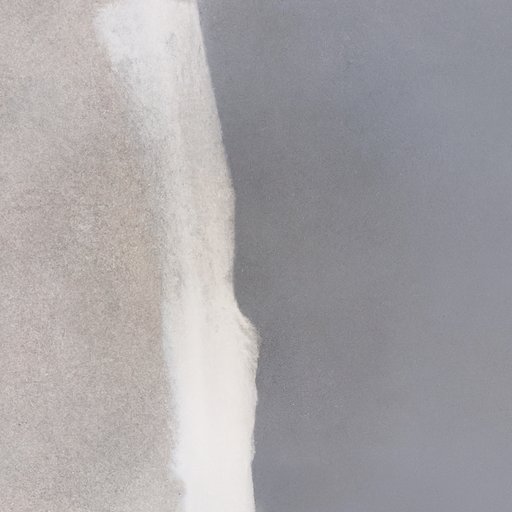
Introduction
Painted concrete surfaces add beauty to your space but when looking to make changes, removing paint can be a daunting task. Paint can stick firmly to concrete surfaces, making it hard to remove without the right tools and techniques. Common causes of paint on concrete surfaces include home renovation projects, spray painting, and spills.
This article offers a comprehensive guide to help you safely remove paint from concrete. Whether you are a homeowner or a contractor, this guide will equip you with the necessary skills to make paint removal easier, quicker and more effective.
A Step-by-Step Guide to Remove Paint from Concrete: Tips and Techniques
Before starting any paint removal project, gather the tools and materials required. You’ll need:
- safety goggles
- respirator mask
- long sleeves and pants
- gloves
- pressure washer, hose and nozzle
- chemical paint stripper (if opting for this method)
- paint scraper
- stiff-bristled brush
Once you have your tools ready, follow these step-by-step instructions to remove paint from the concrete surface:
- Protect yourself by wearing the necessary protective gear.
- If there is loose paint on the concrete surface, use a paint scraper to remove it. If the paint is still hard and adhered to the surface, use a pressure washer to wash it off.
- If chemical paint stripper is needed, apply it as directed according to the manufacturer’s instructions. Allow it to sit for the specified time, usually between 30-60 minutes.
- When the paint is softened by the stripper, use a paint scraper to carefully remove it. You might need a stiff-bristled brush to remove the stubborn paint.
- Rinse off the surface with a high-pressure water spray. Allow the concrete surface to dry completely before applying a fresh coat of paint.
What Works Best? Comparing Different Methods to Remove Paint from Concrete Surfaces
When it comes to removing paint from concrete surfaces, there are a number of options available. Each method comes with its pros and cons. By analyzing these methods, you can choose the most effective and efficient method for your job.
One popular method is sandblasting, which uses high-pressure sand to blast the paint off the surface. Sandblasting is fast and effective but it creates a lot of dust, and it is not suitable for indoor or small spaces.
Another option is chemical paint strippers. Chemical paint strippers work by softening the paint, which makes it easier to scrap off. Chemical paint strippers can be harsh and dangerous to handle if not used properly, but they are very effective in removing multiple layers of paint.
Finally, pressure washing is a great choice for removing paint from small surfaces. It is cost-effective, requires no chemicals and is environmentally friendly. However, it may not be effective in removing multiple layers of paint.
DIY Paint Removal: Using Household Products to Get the Job Done on Your Concrete
You don’t necessarily need chemical paint strippers to remove paint from concrete surfaces. Many common household products can be used. Here are a few options you can try:
- Vinegar: Mix one part vinegar with one part water and spray it onto the paint. Leave it for 30 minutes and then scrub it with a stiff-bristled brush.
- Baking soda: Mix baking soda and water to make a paste and applying it on the stain. Leave it for several hours before scrubbing.
- Citrus-based paint stripper: Citrus oil-based paint strippers are less hazardous than traditional chemical strippers. These strippers are effective in breaking down paint, making it easier to remove.
The Pros and Cons of Chemical vs Natural Paint Removal Methods for Concrete Floors
When considering paint removal on concrete floors, it is important to evaluate the pros and cons of chemical and natural methods. While chemical paint removal methods are faster and more effective, they can be harsh and dangerous to handle. Natural paint removal methods are more environmentally friendly but can be time-consuming.
While each method has its advantages and disadvantages, natural paint removal methods are safer and more eco-friendly. Natural paint removal methods also tend to produce better results when removing paint from small areas.
The Ultimate Guide to Removing Paint from Concrete: Prepping, Stripping and Sealing
To get the best results from your paint removal project, it is important to prep, strip and seal your concrete surfaces properly. Follow these steps:
- Clean the concrete surface thoroughly before starting to strip the paint.
- Protect yourself by wearing protective gear such as a respirator mask, gloves, long pants and sleeves, and safety goggles.
- If using chemical paint strippers, read and follow the manufacturer’s directions carefully.
- Avoid using vehicles or heavy equipment on the concrete surface for at least two days after stripping the paint to prevent damage to the surface.
- Seal the surface after paint removal to prevent future staining or damage. Use a clear sealer after the surface is clean and dry.
Conclusion
Removing paint from concrete surfaces can be a complex task, but it is achievable with the right tools and techniques. In this guide, we have explored the different methods of removing paint from concrete surfaces and discussed the advantages and disadvantages of each method. We have also discussed the importance of safety precautions and the necessary protective gear. It is important to follow the right steps when removing paint from concrete surfaces to get the best results.
We recommend that you use a natural paint removal method for small areas, but for larger areas, it is advisable to use chemical paint strippers. After removing the paint, it is crucial to seal the surface with a clear sealer to prevent future damage and staining. Finally, we encourage you to share your experience or ask questions in the comment section below.





